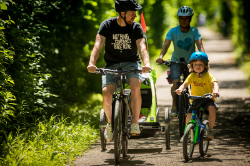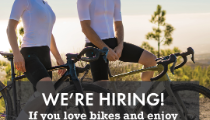Is it time for your child to learn how to ride a bike? It is an exciting rite of passage for both you and your child. Below we have outlined the steps to follow so the experience is not only effective but also fun!
Keep in mind that children learn at different rates, some kids may pick up these skills in a few short hours where others may take a little longer. The below should be used as a guide, it is important to go at your child’s pace and do what works for them, after all you want them to have fun and fall in love with riding!
-
Choosing the right bike
It may seem like the sensible choice, but purchasing a bike that your child will eventually ‘grow into’ can have negative effects on your child’s progress. If the bike is too large it will be difficult for them to reach the ground and feel comfortable. To ensure you have purchased the correct size, check that your child is able to stand comfortably over the top tube, with both feet planted on the floor. You can take your child into your local Bicycle Centre store if you are unsure or you can check out our kids range now >>
-
Choosing and fitting a helmet
The helmet should sit level across the middle of your child’s forehead. It should be a snug fit, if you are able to move the helmet from side to side more than 1 inch, you may need to adjust the straps tighter. If you are unsure, you can visit your local Bicycle Centre store and our friendly staff will ensure your child’s helmet is fitted correctly. Shop our range of kid’s helmets >>
-
Getting the bike ready
There are a couple of different options for this stage. If you child has already been riding a balance bike, removing the pedals may not be required. However if this is their first bike, we recommend removing the pedals so they can learn to balance first.
Remove the training wheels. This will help your child get a feel for the bike and help them learn to balance.
Remove pedals and lower the seat. This will allow your child to sit upright on the seat, with their legs straight and feet flat on the ground. The idea here is to help them feel more comfortable and steady on the bike, before adding pedals.
Properly inflate the tyres. This will simply help the bike roll more smoothly, making it easier for your child to coast or scoot on the bike. Recommended tyre pressure can normally be found on the side wall of the tyre.
-
Learning without pedals
Starting with your child scooting on their modified bike can help them get the feel of balancing on it. Once they are confident challenge them to pick their feet up and coast. See if they can make it to the count of 10 or run through the alphabet!
You may find your child will naturally start doing this without being prompted. Once they are confident you can move on to turning and steering.
Start with big easy loops, and keep it fun with some games. You can set up some cones or markers for your child to ride around or even place some crackers on the floor and encourage them to roll over the top. This will teach them to direct the bike to a specific target.
-
Riding with pedals
Replace the pedals you removed earlier, but keep the seat lower so your child can easily plant their feet back on the ground when needed.
Pedal awareness
Begin with your child sitting on the bike with their eyes closed, while you hold the bike steady. Then have them raise their knees up high above their waist, and find the pedals with their feet. This will give them an idea of where the pedals sit on the bike, and help with stabilisation.
Pedalling
Now it is time to start teaching your child how to begin pedalling. Have them stand over the bike with one foot planted on the ground and the other placed one their pedal at the 2 o’clock position. Then have your child apply pressure to the front pedal to get the bike rolling. Encourage them to lift their back foot and find the other pedal.
At this stage you can place your hand on their shoulder or the bike saddle to help steady them, however it is important to let them learn to balance on their own.
Steering and pedalling
Once your child has gotten the hang of pedalling, they can begin to practice turns. Use the same concept you applied earlier and set up come cones or markers for your child to manoeuvre around or a cracker they can run over. Keep it fun and steadily increase the difficulty as they gain more confidence.
Stopping the bike
Have your child press on the hand brake gently at first, until they are able to use it without wobbling too much. To practice this you can create another game. Place a safety cone or marker a few metres ahead and have your child stop once they reach them.
Once your child has become more confident braking you can raise the saddle height back to normal. To check it is at the correct height have your child sit on the bike, at the bottom of the pedal stroke their leg should be about 80-90% straight in the knee.
-
Let the fun begin!
Once your child can ride fairly well, it’s time for you to put on your helmet and have a bit of fun. Go for an easy ride (this can be in the same area you practiced) and have your child follow you, throw in a few larger turns and brakes, but remember to take it easy and slow at first.
Remember to focus on your child’s success rather than point out any mistakes they may make, remember to stop and take a break when needed, but most importantly have fun!
If you require any advice or assistance with anything mentioned above please get in touch with your local Bicycle Centre Store. Our friendly team of staff is always happy to help.






